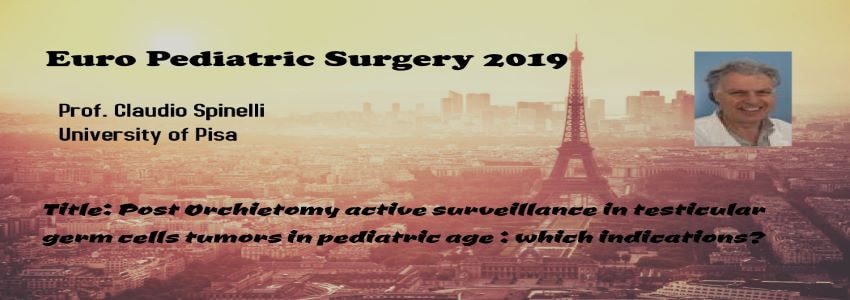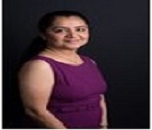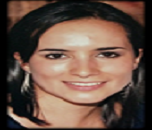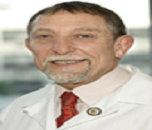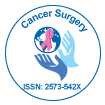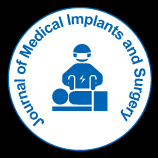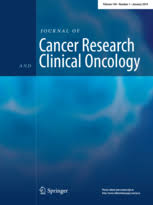Euro Pediatric Surgery 2019 cordially welcomes you to attend the 12th Annual meet on Pediatric Surgery and Pediatrics, which is going to be held in Paris, France during May 13-14, 2019. We would like to invite all the participants who are interested in sharing their knowledge and research in the area of Pediatrics and Pediatrics Surgery.
Pediatric surgery is a subspecialty of surgery involving the surgery of fetuses, infants, children, adolescents, and young adults.Subspecialties of pediatric surgery itself include: Neonatal Surgery and Fetal Surgery.
Our ambition is to layout the bridge and enhance a network where our researchers , our clinical institutional doctors, nurses, industry related researchers and contributors of related field can share their ideas, modern day research, their experience, associated problems, imaginative theories, frameworks, methodologies, tools, applications and questions throughout the scientific community.
This conference provides the best opportunity to inspire and influence the largest assemblage of contributors from pediatrics surgery and overall pediatrics community.
Pediatrics and child care is not only limited to mere treatment of sick children it has rather expanded as a discipline that involves nurturing the young ones into healthy adolescents, by focusing on their physical, emotional and social growth.
The aim of this conference is to provide a platform that would mainly focus on surgical pediatrics health and neonatology, neonatal infectious disease, neurological and genetic disorders, complications during pregnancy, prenatal diagnosis, neonatal ophthalmology, neonatal and pediatric nutrition related issues, pediatric endocrinology, gastroenterology, oncology, haematology, hepatology, rheumatology etc.
Pediatric Surgery
Pediatric surgery is a subspecialty of surgery involving the surgery of fetuses, infants, children, adolescents, and young adults. Subspecialties of pediatric surgery itself include: neonatal surgery and fetal surgery. Other areas of surgery also have pediatric specialties of their own that require further training during the residencies and in a fellowship: pediatric cardiothoracic (surgery on the child's heart and/or lungs, including heart and/or lung transplantation), pediatric nephrological surgery (surgery on the child's kidneys and ureters, including renal, or kidney, transplantation), pediatric neurosurgery (surgery on the child's brain, central nervous system, spinal cord, and peripheral nerves), pediatric urological surgery (surgery on the child's urinary bladder and other structures below the kidney necessary for ejaculation), pediatric emergency surgery, surgery involving fetuses or embryos (overlapping with obstetric/gynecological surgery, neonatology, and maternal-fetal medicine), surgery involving adolescents or young adults, pediatric hepatological (liver) and gastrointestinal (stomach and intestines) surgery (including liver and intestinal transplantation in children), pediatric orthopedic surgery (muscle and bone surgery in children), pediatric plastic and reconstructive surgery (such as for burns, or for congenital defects like cleft palate not involving the major organs), and pediatric oncological (childhood cancer) surgery. Common pediatric diseases that may require pediatric surgery includes: congenital malformations, abdominal wall defects, chest wall deformities, childhood tumors etc.
Pediatric Related Societies and Associations:
AUSTRALIA:
USA:
EUROPE:
Pediatric Cardiac surgery
Pediatric Related Societies and Associations:
AUSTRALIA:
USA:
EUROPE:
Pediatric Gastrointestinal surgery
Pediatric Related Societies and Associations:
AUSTRALIA:
USA:
EUROPE:
Pediatric Ophthalmic surgery
Pediatric Ophthalmology basically focuses on issues which affect the pediatric vision such as pediatric uveitis, genetic eye disease, developmental abnormalities and more. Pediatric ophthalmologists mainly concentrate on visual system and different eye disorders that disturb the vision in children. It is recommended to have regular vision screening of your child to avoid permanent vision damage. The initial symptoms include abnormal tilting, movements of the eye and improper alignment of both the eyes. Neonatal retina disorders occur when the retina malfunctions. Genetic Eye Disease is often and frequently inherited. Nystagmus is an involuntary, rhythmic oscillation of the eyes. The eye movements can be side-to-side, up and down or rotary. It may be present at birth or acquired later in life. Other disease includes: Pediatric Cataract, Pediatric Glaucoma, Retinopathy of Prematurity, Strabismus, Myopia, Nystagmus, Hyperopia, Developmental Abnormalities etc. Childhood Malignancies Congenital Cataract Congenital Glaucoma Nystagmus Strabismus Trauma Diagnostic & Screening
Pediatric Related Societies and Associations:
AUSTRALIA:
USA:
EUROPE:
Pediatric surgical oncology
Pediatric oncology is the research and treatment of cancers in children and young adults. Pediatric oncologists study and train in both pediatrics and oncology. The types of cancers that develop in children are often different from cancers that develop in adults. Because of this, pediatric oncologists specialize in treating infants, children, young adults and teenagers who have cancer. Childhood cancers can develop as the result of DNA changes in cells that occur early in life, even before birth. Some adult cancers are linked to environmental or lifestyle factors. Cancers that occur in children are very rarely related to any type of environmental or lifestyle factor. Childhood cancers include:
Brain and spinal cord tumor (a disease in which abnormal cells form in the tissues of the brain or spinal cord. The majority of childhood brain tumors are diagnosed and removed in surgery. These types of tumors account for about one-fourth of childhood cancers)
Leukemia (This cancer affects the body's blood-forming tissues, including the bone marrow and lymphatic system. Leukemia accounts for almost one-third of all cancers in children.)
Lymphoma (There are two main types of this group of blood cancers that develop in the lymphatic system: Hodgkin's lymphoma and non-Hodgkin's lymphoma. Both types of lymphoma occur in children, making up a combined 8 percent of childhood cancers.)
Neuroblastoma (This rare type of cancer nearly always affects children. Neuroblastoma develops from nerve cells in the fetus known as neuroblasts. Neuroblastoma can be inherited and these types of tumors usually develop in the adrenal glands.)
Other common childhood cancers include Wilms tumor, Rhabdomyosarcoma, Retinoblastoma and bone cancers such as Osteosarcoma and Ewing sarcoma.
Pediatric Related Societies and Associations:
AUSTRALIA:
USA:
EUROPE:
Pediatric Orthopedic surgery
Pediatric Related Societies and Associations:
AUSTRALIA:
USA:
EUROPE:
Pediatric Plastic and Reconstructive surgery
Pediatric Related Societies and Associations:
AUSTRALIA:
USA:
EUROPE:
Pediatric Emergency Medicine
Pediatric emergency medicine (PEM) is a medical subspecialty of both pediatrics and emergency medicine. It involves the care of undifferentiated, unscheduled children with acute illnesses or injuries that require immediate medical attention. While not usually providing long-term or continuing care, pediatric emergency doctors undertake the necessary investigations and interventions to diagnose patients in the acute phase, to liaise with physicians from other specialties, and to resuscitate and stabilize children who are seriously ill or injured.
Pediatric Related Societies and Associations:
AUSTRALIA:
USA:
EUROPE:
Maternal health and neonatology
Maternal health is the health of women during pregnancy, childbirth, and the postpartum period. To maintain maternal health four elements are essential: prenatal care, skilled birth attendance with emergency backup, emergency obstetric care and postnatal care.
Neonatology is a subspecialty of Pediatrics that deals with infants who are ill or require special medical care due prematurity, low birth weight, intrauterine growth restriction, birth defects.
Birth Asphyxia is a medical condition resulting from deprivation of oxygen to a new-born infant during the birth process that usually affects the brain, whereas fetus death at or after 20 to 28 weeks of pregnancy or during delivery is medially termed as Stillbirth. Premature birth is a birth that takes place more than three weeks (fewer than 37 weeks gestational age) before the baby's estimated due date. Intrapartum Fetal Monitoring are the monitoring techniques that are used immediately preceding or during childbirth. Structured intermittent auscultation is a technique that employs the systematic use of a Doppler assessment of fetal heart rate (FHR) during labor at defined timed intervals. Ultrasound/image guided fetal intervention is the method of manipulating the fetus without either an incision in the uterus, or an endoscopic view inside the uterus. The manipulation is done entirely under real-time cross-sectional view provided by the sonogram. Spina Bifida is a birth defect that occurs when the spine and spinal cord don't form properly and part of the spinal cord and its meninges are exposed through a gap in the backbone, thus to reduce the risk of preterm premature rupture of membranes Fetoscopic repair of Spina Bifida is done.
Pediatric Related Societies and Associations:
AUSTRALIA:
USA:
EUROPE:
Neonatal infectious diseases
Candidiasis is an infection caused by a species of the yeast belonging to genus Candida. There are over 20 species of Candida yeasts that can cause infection in humans; the most common of which is Candida albicans. It can cause vaginal candidiasis, oral candidiasis and deep organ candidiasis. Conjunctivitis is a type of neonatal infection that affects the new-borns while they pass through the birth canal from a mother infected with either Neisseria gonorrhea or Chlamydia trachomatis during delivery. Meningitis is an inflammation of the meninges and is more common in the neonatal period .It is an important cause of morbidity and mortality globally. Sepsis specifically refers to the presence in a new-born baby of a bacterial blood stream infection. Neonatal tetanus is a form of generalized tetanus that occurs in new-borns. It usually occurs through infection of the unhealed umbilical stump, particularly when the stump is cut with a non-sterile instrument. Neonatal stroke is a disturbance in the blood supply to an infant's brain in the first 28 days of life. This includes both ischemic events, which result from the blockage of vessels, and haemorrhagic events, which result when the blood vessel ruptures and bleeds. Neonatal diabetes mellitus is a disease that affects the infants and their body's ability to produce or use insulin .It is a monogenic (controlled by a single gene) form of diabetes that occurs in the first 6 months of life. Neonatal herpes simplex is a rare but serious condition, usually caused by vertical transmission of herpes simplex virus from mother to the new-born. Other infectious diseases includes: Neonatal hypoglycaemia, Neonatal adrenoleukodystrophy , Neonatal isoerythrolysis, diffuse neonatal hemangiomatosis, benign neonatal hemangiomatosis, Neonatal cholestasis, Transient neonatal pustular melanosis, and Neonatal toxic shock-like exanthematous disease.
Pediatric Related Societies and Associations:
AUSTRALIA:
USA:
EUROPE:
Neurological and Genetic disorders
Cerebral Palsy is a group of permanent movement disorders that appear in early childhood and is caused by abnormal development or damage to the parts of the brain that control movement, balance and posture. Periventricular leukomalacia (PVL) characterized by the necrosis (more often coagulation) of white matter near the lateral ventricles (is a form of white-matter brain injury). White matter damage can cause severe problems with motor coordination or organ function. Most frequent signs include delayed motor development, vision deficits, apneas, low heart rates, and seizures. Abnormal Brain Development begins long before the baby is born. It damages the developing nervous system or causes it to develop abnormally. Sometimes it's a genetic reason, or may be because of exposure to certain medicines, infections, or radiation during pregnancy that interferes with brain development. Intracranial Haemorrhage refers to any bleeding within the intracranial vault, including the brain parenchyma and surrounding meningeal spaces. Bilirubin encephalopathy is a rare neurological condition that occurs in some new-borns because of very high levels of bilirubin. If the level of bilirubin is very high, this can lead to brain damage and hearing loss. Acute intermittent porphyria is a genetic metabolic disorder affecting the production of haem, the oxygen-binding prosthetic group of haemoglobin. ADULT syndrome (Acro–dermato–ungual–lacrimal–tooth) is a rare genetic disease .It is an autosomal dominant form of ectodermal dysplasia, a group of disorders that affects the hair, teeth, nails, sweat glands. The syndrome arises from a mutation in the TP63 gene .Other disorders include: Aicardi–Goutières syndrome, Alexander disease, Alternating hemiplegia of childhood, Birt–Hogg–Dubé syndrome, Brunner syndrome, Aarskog–Scott syndrome, ABCD syndrome, Sickle-cell disease, Spinal muscular atrophy, Color blindness, Haemochromatosis, Autism, Alexander disease, Batten disease, Childhood disintegrative disorder, Leigh syndrome, Lysosomal storage disease, Neonatal encephalopathy etc.
Pediatric Related Societies and Associations:
AUSTRALIA:
USA:
EUROPE:
Neonatal Respiratory Diseases
Other types of cyanosis includes: Peripheral cyanosis, Differential cyanosis, Central cyanosis. Other respiratory diseases are: Pneumothorax, Chronic Lung Disease, Meconium Aspiration, Apnea of Prematurity, Transient Tachypnea of the new-born, Persistent Pulmonary Hypertension, Bronco pulmonary dysplasia, Thromboembolism etc. Acute respiratory failure occurs when fluid build-up blocks the air sacs in lungs. Obstructive lung disease damages the lungs by narrowing the airways inside the lungs. Types of obstructive lung disease includes: asthma, bronchiectasis, bronchitis and chronic obstructive pulmonary disease. Restrictive lung disease is chronic lung condition that limits the ability of a person's lungs to expand during inhalation. Pulmonary edema is the accumulation of fluid in the tissue and air spaces of the lungs. It leads to impaired gas exchange and may cause respiratory failure. Other respiratory failures includes: Viral pneumonia, bacterial pneumonia, fungal pneumonia, Spontaneous pneumothorax etc.
Pediatric Related Societies and Associations:
AUSTRALIA:
USA:
EUROPE:
Prenatal, Neonatal and Pediatric Nutrition
Prenatal nutrition addresses nutrient recommendations before and during pregnancy. Prenatal nutrition has a strong influence on birth weight and further development of the infant. Neonatal nutrition involves the dietary needs of newborns and infants. Infant formula is available for babies whose mothers are unable to breastfeed. Breast milk contains antibodies that help the baby fight off viruses and bacteria. Breastfeeding lowers the baby's risk of having asthma or allergies. Babies who are breastfed exclusively for the first 6 months, without any formula, have fewer ear infections, respiratory illnesses, and bouts of diarrhoea. Maternal food uptake /maternal nutrition are vital during pregnancy and health of the offspring. Failure in supplying the adequate amount of nutrients to meet fetal demand can lead to fetal malnutrition. Essential fatty acids (ARA and DHA) are essential because it supports the brain, eye and nervous system development in the womb and during the first few years of life. Paediatric malnutrition encompasses both over-nutrition, associated with overweight and obesity and under nutrition, referring to multiple conditions including acute and chronic malnutrition and micronutrient deficiencies. Pediatric counterbalance diet ensures the uptake of food in the right proportions. Pediatric Food allergies occur when the body's immune system overreacts to certain foods. Any food could cause a food allergy, but most of the food allergies are caused by Eggs, Peanuts, Soy, and Wheat etc. Eating disorders are caused by abnormal eating habits that negatively affect a person's physical or mental health. These includes binge eating which is a pattern of disordered eating which consists of episodes uncontrollable eating and anorexia nervosa where people eat very little and thus have a low body weight. Meal composition and variability also plays a major role in Nutrient deficiency disorders and chronic disease etc.
Pediatric Related Societies and Associations:
AUSTRALIA:
USA:
EUROPE:
Pediatric Endocrinology and Pediatric Rheumatology
Placental hormones include human chorionic gonadotropin (HCG), progesterone, estrogen, and human placental lactogen (hPL). Placental hormones such as HCG help in maintaining the corpus luteum during the early stages of pregnancy. Progesterone is a hormone produced by the ovaries and later, if pregnancy occurs. In the second half of the menstrual cycle after ovulation, progesterone prepares the uterine lining (endometrium) to receive the fertilized egg. Human placental lactogen modifies the metabolic state of the mother during pregnancy to facilitate the energy supply of the fetus. Patients with childhood or adult-onset GH deficiency (GHD) have reduced left ventricular mass (LVM) and ejection fraction (EF).Hormonal imbalance/balance is also involved in sexual development, pediatric obesity, metabolic activity etc. Thyroid is a common problem that causes over or under function of the thyroid gland. Hyperthyroidism describes excessive production of thyroid hormone. Non - inflammatory joint pains (osteoarthritis) is a type of joint disease that results from breakdown of joint cartilage and underlying bone. Chronic recurring multifocal osteomyelitis / Chronic Recurrent Multifocal Osteomyelitis, is a rare condition in which the bones have lesions, inflammation, and pain. Juvenile Idiopathic Arthritis is the most common type of arthritis in children under the age of 16.It can cause persistent joint pain, swelling and stiffness, growth problems, joint damage and eye inflammation.
Pediatric Related Societies and Associations:
AUSTRALIA:
USA:
EUROPE:
Pediatric Oncology / haematology and Pediatric Nephrology
Pediatric oncology is the branch of medicine concerned with the diagnosis and treatment of cancer in children whereas Haematology is the branch of medicine involving study and treatment of the blood. Pediatric nephrologists diagnose, treat, and manage many disorders affecting the kidney and urinary tract, including kidney failure, high blood pressure, inherited kidney diseases, kidney stones, urinary tract infections, and abnormalities in the urine such as blood and protein. Haematuria is the presence of red blood cells in the urine. Causes of haematuria are broad, ranging from urinary tract infection to kidney stones to bladder cancer. Glomerulonephritis is a term used to refer to several kidney diseases (usually affecting both kidneys).
Renal transplantation is the organ transplant of a kidney into a patient with end-stage renal disease. Nephrotic syndrome is a collection of symptoms due to kidney damage. Symptoms include: weight gain, feeling tired and foamy urine, blood clots, infections, and high blood pressure. Other diseases includes: Fluid and electrolyte problems, Systemic lupus erythematosis, Kidney stones, Proteinuria etc.
Pediatric Related Societies and Associations:
AUSTRALIA:
USA:
EUROPE:
Behavioural and Development pediatrics
Developmental- behavioural pediatricians evaluate, counsel, and provide treatment for children, adolescents, and their families with a wide range of developmental and behavioural difficulties including: Learning disorders including dyslexia, writing difficulties, math disorders, and other school-related learning problems, Attention and behavioral disorders including attention-deficit/hyperactivity disorder and associated conditions including oppositional-defiant behavior, conduct problems, depression, and anxiety disorders, Tics, Tourette syndrome, and other habit disorders, Regulatory disorders including sleep disorders, feeding problems, discipline difficulties, complicated toilet-training issues, enuresis (bedwetting), and encopresis (soiling), Developmental disabilities including cerebral palsy, Spina bi fida, mental retardation, autism spectrum disorders, and visual and hearing impairments, Delayed development in speech, language, motor skills, and thinking ability, Behavioral and developmental problems complicating the full range of pediatric chronic illnesses and disabling conditions (for example, genetic disorders, epilepsy, prematurity, diabetes, asthma, cancer).
Pediatric Related Societies and Associations:
AUSTRALIA:
USA:
EUROPE:
Disease Epidemiology
Epidemiology is the study and analysis of the distribution (who, when, and where) and determinants of health and disease conditions in defined populations. It is the cornerstone of public health, and shapes policy decisions and evidence-based practice by identifying risk factors for disease and targets for preventive healthcare. Epidemiologists’ help with study design, collection, and statistical analysis of data, amend interpretation and dissemination of results (including peer review and occasional systematic review). Epidemiology has helped develop methodology used in clinical research, public health studies, and, to a lesser extent, basic research in the biological sciences.
There are 6 components of the infectious disease process constituting chain of disease transmission i.e. the agent, its reservoir, its portal of exit, its mode of transmission, its portal of entry, susceptible host.
Pediatric Related Societies and Associations:
AUSTRALIA:
USA:
EUROPE:
Immunization and Vaccination
Immunization is the process by which an individual's immune system becomes fortified against a pathogen. Immunization is done through various techniques, most commonly through vaccination. Immunization can be achieved in active or passive manner. Immunization schedule is designed to protect infants and children early in life when they are most vulnerable to various diseases. For example: After birth, the baby receives first dose of hepatitis B. After 1 to 2 months of age: Hepatitis B (Second dose), Polio, Diphtheria, tetanus and whooping cough etc. After 4 to 6 months of age: Pneumococcal, polio, hepatitis B etc and so on.
The most common and serious vaccine-preventable diseases tracked by the World Health Organization (WHO) are: diphtheria, Haemophilus influenzae serotype b infection, hepatitis B, measles, meningitis, mumps, pertussis, poliomyelitis, rubella, tetanus, tuberculosis, and yellow fever. The WHO lists 26 diseases for which vaccines are available.
A vaccine that is generally recommended may be medically inappropriate for a small number of people due to severe allergies or a damaged immune system. In addition, a vaccine against a given disease may not be recommended for general use in a given country, or may be recommended only to certain populations, such as young children or older adults.
Pediatric Related Societies and Associations:
AUSTRALIA:
USA:
EUROPE:
Pediatric Dermatology
A pediatric dermatologist cares for children (newborns through adolescents) with skin disorders. They generally provide services like: Diagnosis of various skin conditions, including hemangiomas and other vascular birthmarks, pigmented birthmarks, and congenital skin disorders, eczema or atopic dermatitis, psoriasis, contact dermatitis, vitiligo, hives etc, Medical/prescription treatment for a wide variety of conditions affecting the skin, hair, and nails, Minor surgical procedures including skin biopsies, surgical removal of skin lesions and laser treatment of vascular birthmarks.
Pediatric Related Societies and Associations:
AUSTRALIA:
USA:
EUROPE:
Recent advances in Pediatric Gastroenterology and Hepatology
Gut microbiome in specific, has become the main research interest in clinical, medical and microbiology fields to know up to which extent the gut microbiota sustain health and how its disruption might contribute to disease pathogenesis. A major role for the gut microbiota in liver disorders is also supported by the accumulating evidence that several complications of severe liver disease such as hepatic encephalopathy are efficiently treated by various prebiotics, probiotics and antibiotics. Genetics and genomics are beginning to strongly influence the care of patients from common disorders such as colorectal cancer, pancreatitis and liver cancer; to rare conditions like hereditary disorders. Hepatic stellate cells are pericytes found in the perisinusoidal space of the liver, whose main functions is to store vitamin A and probably to maintain the normal basement membrane-type matrix. Gastroesophageal reflux disease is a long-term condition where stomach contents come back up into the esophagus resulting in complications. Symptoms include: burning sensation in your chest, heartburn, vomiting etc. Peptic ulcers are open sores that develop on the inside lining of your stomach and the upper portion of your small intestine. Peptic ulcers include gastric ulcers, duodenal ulcers. Fatty liver is a reversible condition wherein large vacuoles of triglyceride fat accumulate in liver cells via the process of steatosis .Other diseases include: Inflammatory Bowel disease (Crohn’s Disease and Ulcerative Colitis) , Inguinal hernia in children , Hypertrophic Pyloric Stenosis , Constipation, Hirschsprung’s Disease , Lactose intolerance etc.
Pediatric Related Societies and Associations:
AUSTRALIA:
USA:
EUROPE:
Pediatric market analysis reports and industry analysis
Pediatrics is the branch of medicine dealing with the care of infants, children and adolescents and the prevention and treatment of their diseases. Although most thinking and analysis of health care is taken from the adult health care system, issues surrounding pediatrics are unique and challenging and should be treated differently than adults. A major challenge that pediatric healthcare community faces is in relation to Medicaid funding. While the cost of health care for most children is relatively low, those who require hospitalization or specialty care experience a tremendous increase in total cost. Additionally, with a focus on preventative medicine, more resources need to be allocated to paediatrics. Medicaid funding for children estimates about 20 per cent of total funds, yet children makes up about 60 per cent of enrolees. Typically, nursing homes and geriatrics utilize the most Medicaid dollars but for a much smaller population. While healthcare reform is an on-going issue, the unique needs of children need to be included.
According to report titled, "Pediatric Healthcare Products and Services Market - Global Industry Analysis, Size, Share, Growth, Trends, and Forecast, 2018 –2026”.the global pediatric health care products and services market was valued at US$ 88,000 Mn and US$ 520,000 Mn, respectively, in 2017 and is projected to expand at a CAGR of 4.5% and 5.5% from 2018 to 2026. Rise in disorders and diseases among children are expected to drive demand for drugs used in the treatment of these conditions from 2018 to 2026.The report offers detailed segmentation of the global paediatric health care products and services market based on drug class, diseases/disorders, and services type. In terms of drug class, the antibiotics segment is projected to capture major share of the market from 2018 to 2026.The antidepressants segment is likely to account for 4.0% market share by 2026 due to rise in the number of children and adolescents affected with depression and anxiety across the world.
According to the report, the global pediatric health care products and services market was valued at around US$ 88,000 Mn and US$ 520,000 Mn, respectively, in 2017 and is projected to expand at a CAGR of around 4.5% and 5.5%, respectively, from 2018 to 2026. Unhealthy lifestyle habits and rise in obese pediatric population propel the pediatric health care products and services market. The world is going through a rapid nutritional and epidemiological shift, rise in prevalence of obesity, cardiovascular disease, nutrition-related chronic diseases, and cancer. Changes in lifestyle, for instance, in eating habits, have led to an increase in obesity. Obesity is a growing problem in developed as well as in developing countries. Obese or overweight children are likely to remain obese in their adulthood and are susceptible to non-communicable diseases, such as cardiovascular diseases and diabetes, at a younger age. According to a study conducted by the World Health Organization (WHO), in 2016 the number of overweight children, under the age of five, was estimated at more than 41 million globally. Almost half of all overweight children under five years of age lived in Asia and one quarter lived in Africa.
Pediatric Vaccines Market Analysis
The global paediatric vaccines market size was estimated at USD 22.4 billion in 2016. Increase in government and non-government funding for development of novel vaccines, along with initiatives for raising awareness about immunization, is likely to have a positive impact on market growth. High prevalence of chronic diseases is one of the major factors boosting the market for paediatric vaccines. According to WHO, around 5 billion severe illnesses and 0.5 billion annual deaths are reported globally. Infants are at a higher risk of contracting severe diseases, and therefore, vaccination plays an important role in their prevention. According to WHO, in 2015, around 134,200 people died due to measles, which accounted for nearly 15 deaths every hour. It also estimated that around 19.5 million children worldwide did not receive DTP vaccines in 2016.
Euro Pediatric Surgery 2019 will be happy to help you in all ways to plan your trip to Paris, France.We will be happy to help you with the official invitation letter for the approval of your VISA.
Mail us at [email protected]
When applying for a visa to Europe you will have to submit some required documents as part of the Schengen Visa Application.
The following list of documents is required for any short-term Schengen visa application:
-
Visa application form. Fully completed and signed.
-
Two recently taken photos must be attached. Both photos must be taken within the last three months, according to the visa photo requirements.
-
A valid passport. Not older than 10 years and it should valid for at least three more months beyond the date you plan to leave Schengen area. Older passports with visas on them (if you have any).
-
Round trip reservation or itinerary. It must include dates and flight numbers specifying entry and exit from the Schengen area. You can use the visa consultation services. These guys can handle most of your visa requirements such as flight itineraries, hotel reservations along with free consultation over email.
-
Travel insurance policy. A document that proves you have travel health insurance for the whole Schengen territory, with a minimum coverage of 30,000 euros in case of any medical emergency as illnesses, accidents and even repatriation in case of death.
-
Proof of accommodation. A document that shows where you will be accommodated throughout your stay in Schengen. This can be one of the following:
Gracing the banks of the Seine River, Paris has a way of romancing visitors with its elegant beauty and magical ambience. This incomparable city is filled with grandiose monuments like the Eiffel Tower, Notre-Dame, and the Champs-Elysées Boulevard. Yet the charm of Paris lies in the small details: the quaint cobblestone streets, prettily trimmed trees, perfectly puffed pastries, dainty tea salons, Belle Epoque brasseries, and avant-garde art galleries. Like a veritable open-air museum, the city's buildings are works of art, and the Parisians' everyday fashion is worthy of a magazine spread.
From stylish boutiques to exquisite cuisine, Paris is synonymous with the finer things in life. The city celebrates its cultural heritage by assiduously maintaining its historic landmarks, formal French gardens, and world-class art collections.In every hidden corner and at all the famous sites, Paris casts a spell of enchantment.
15 things to do for free in Paris:
-
Go on a free walking tour
-
Explore the city’s beautiful parks
-
Soak up the atmosphere along the scene at night
-
Stroll down the Champs-Elysees
-
Check out the stunning Notre Dame Cathedral
-
Watch the Eiffel tower sparkle
-
Explore the diverse Paris neighbourhoods
-
Enjoy live music at ‘Showcase’
-
Check out the Pere Lachaise Cemetery
-
Enjoy free entertainment at Place de la Concorde
-
Take in the view from Sacre Coeur in Montmartre
-
Check out a fashion show at Galeries Lafayatte
-
Listen to an organ concert at Saint-Eustache Church
-
Visit the main museums on the first Sunday of the month.
This gathering will be a huge and important stage for stirring worldwide and interdisciplinary exchange at the forefront of pediatric surgery and pediatrics. Interaction with present and potential scientists, the course of action of talks, presentations and workshops on pediatric and child care, newest updates in pediatrics are hallmarks of this conference that will keep individuals delighted with learning. This conference is aimed to lead us towards the development of innovative work, new patterns and methodologies via interdisciplinary collaboration for affordable and effective healthcare and child care.
Pediatric Surgery 2017 Report
Conference Series LLC hosted the “11th International Conference on Clinical Pediatrics and Pediatric Surgery”, during June 29- July1, 2017 at London, United Kingdom, which was an incredible achievement. Prominent keynote speakers from various reputed institutions and organizations addressed the gathering with their resplendent presence. The esteemed guests, keynote speakers and researchers shared their innovative research and vast experience knowledge and confabulated on various latest and exciting innovations in all areas of Pediatric Surgery research at the podium of Pediatric Conference 2017.
Active participation and plentiful response were received from the Organizing Committee Members of Conference Series LLC as well as from renowned speakers, Pediatric Surgeons, Talented Researchers and Young Student Community. Researchers and students who attended from different parts of the world has made the conference one of the most successful and productive events in 2016 from Conference Series LLC. The conference was marked with the presence of renowned Surgeons, talented young researchers, students and business delegates driving the three days event into the path of success with thought provoking keynote, plenary speeches and poster presentations and also video presentations.
Pediatric Surgery 2017 Organizing Committee extends its gratitude and congratulates the Honorable Moderators of the conference, Hamed Ali Alghamdi, Al-Hada Armed Forces Hospitals- Taif –KSA, Saudi Arabia and Tinuk Agung Meilany, Indonesia University School of Medicine, Indonesia for their remarkable contribution towards delightful functioning of this esteemed event.
Conference Series LLC extends its warm gratitude to all the Honorable Guests and Keynote Speakers of Pediatric Surgery 2017 for their valuable contribution towards the successful completion of this global summit.
Dr. Robert P Foglia, University of Texas Southwestern Medical Center, USA,
Dr. Andrew J A Holland, The University of Sydney, Australia
Dr. Rizwana Popatia, Weill Cornell Medical College, USA
Dr. Howard I Pryor II, Johns Hopkins University School of Medicine, USA
Dr. Asif Hasan, Aligarh Muslim University, India
Dr. Minu Bajpai, All India Institute of Medical Sciences, India
Conference Series LLC is privileged to felicitate Pediatric Surgery 2017 Organizing Committee, Keynote Speakers, Chairs & Co-Chairs and also the Moderator of the conference whose support and efforts made the conference to move in the path of success. Conference Series LLC thanks every individual participant for their fruitful and active response. This inspires us to continue organizing events and conferences for further research in the field of Pediatrics.
Last but not the least Conferenceseries LLC wishes to acknowledge with its deep sincere gratitude all the supporters from the Editorial Board Members of our Open Access Journals, Keynote speakers, Honourable guests, Valuable speakers, students, delegates and special thanks to the Media partners for their promotion to make this event a huge success.
Pediatric Surgery 2018 Report
Conference Series LLC Ltd organized the "3rd International Conference on Pediatrics and Pediatric Surgery ", during the month of May 07-08, 2018 at Frankfurt, Germany which was an unimaginable accomplishment. Conspicuous keynote speakers from different reputed foundations and associations tended to the social affair with their shining nearness.
The regarded visitors, keynote speakers and specialists shared their inventive research and tremendous experience information and confabulated on different most recent and energizing advancements in every aspect of Pediatric Surgery look into at the platform of Pediatric Conference 2018.
Active participation and copious reaction were gotten from the Organizing Committee Members of Conference Series and also from prestigious speakers, Pediatric Surgeons, Talented Researchers and Young Student Community. Specialists and understudies who gone to from various parts of the world has made the meeting a standout amongst the best and gainful occasions in 2018 from Conference Series The gathering was set apart with the nearness of eminent Surgeons, capable youthful scientists, understudies and business delegates driving the three days occasion into the way of achievement with interesting keynote, all-hands conferences and blurb introductions and furthermore video introductions.
Pediatric Surgery 2018 Organizing Committee extends its gratitude and congratulates the Honorable Moderators of the conference for their remarkable contribution towards delightful functioning of this esteemed event.
Conference Series extends its warm gratitude to all the Honorable Guests and Keynote Speakers of Pediatric Surgery 2018:
After the successful completion of Pediatric Surgery 2018 we are glad to announce our next upcoming conference which is going to be held in London, UK.
ConferenceSeries LLC therefore is glad to announce its “12th Annual meet on Pediatric Surgery and pediatrics 2019”, which will be held during February 27-28, 2019 Paris, France. We cordially welcome all the eminent researchers, students and delegates to take part in this upcoming conference to witness eminent scientific discussions and contribute to the future innovations in the field of Pediatric Surgery and Pediatrics.
-
Pediatricians
-
Pediatrics surgery researchers
-
Neonatologists
-
Professors, Scientists
-
Post Doc./PhD students and young researchers
-
Pediatric Nurse
-
Pediatric Neurologists
-
Pediatric cardiologists
-
Pediatric surgery physicians
-
Pediatric and neonatal pharmacologist
-
Pediatric nutrionists
-
Pediatric Oncologists
-
Gynaecologists
-
Psychiatrists
-
Pediatric nephrologists
-
Pediatric rheumatologists
-
Pulmonologist/respiratory physicians
-
Haematologists
-
Pediatric and neonatal gastroenterologists
-
Pharmaceutical companies engaged in manufacturing, development and commercialization of drugs and pediatric surgical equipments.








